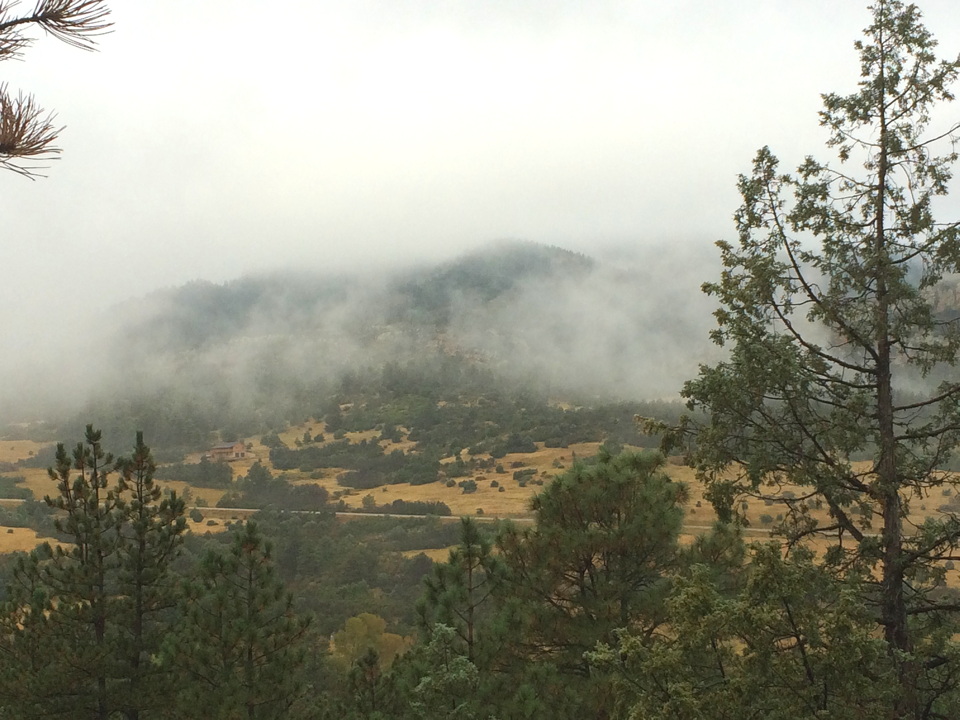
Wednesday was the first nice day in a while, so M. and I went hiking on some national forest land near home. We were on a “social trail,” one that is not signed and listed on the forest maps, but we saw maybe four other people there anyway. I stopped partway up to repair a geocache container — not a cache that I own, but one that has been more or less abandoned by its owners. I feel affection for it because it was the first one that I ever found, so I check on it now and then.
What keeps a lot of geocachers going is not the sheer numbers of caches that they find, but the places that the sport (or hobby) takes them.((Geocaching is a “sport” in that it has rules, and you can be competitive about numbers and categories if you want to be. On the other hand, since I most often do it alone, perhaps it is more a “hobby” or a “pursuit.”)) What they often mention is how caching takes them to unexpcted places that they never knew existed.
For me those include a deserted lakeside resort in central North Dakota where an artesian well gushes water from a big rusty pipe, a tiny cemetary in Taos, New Mexico, a cavalryman’s grave on a Wyoming hillside, or an abandoned bridge on the Dismal RIver in Nebraska’s Sand Hills.((You can also find tiny magnetic containers stuck to benches in city parks, but after a while, they are not so special anymore.))
In a recent episode titled “Force the Hand of Chance: A How-To Guide to Psychogeography” on the Strange Familiars podcast, co-host Alison Renner mentions how recent conditions have meant she and her husband, Timothy, have been exploring the seen and unseen environment of their hometown more these days. When she remarked about walking down an alley that she had never entered before, it reminded me of geocaching.
But insead of using a GPS receiver, the Renners were following a route on a cell phone app called Randonautica, advertised as “The world’s first quantumly generated Choose Your Own Adventure reality game. Explore the world you never knew existed.” ((There is a forum on Reddit, of course: r/randonauts, and a Facebook group. ))
Randonautica app puts the user in the Director’s Chair of an adventure story yet to be written. By using the app, the user can break from their mundane day-to-day and take a journey of randomness into the world around them.
Where the mind goes, the universe follows. The Randonautica app is built with mind-machine interfacing technology which allows the user to drive their trip simply by thinking.
A user in Cambodia wrote on Reddit, “Set my intent to’find a portal to another world’…found an arch that led me to a wealthy gated community. Compared to the poverty that most people here live in, it is certainly another world for them.”

Part of the Strange Familiars podcast episode is the Renners trying out the Randonautica app and experiencing at least one strong synchronicity. Timothy Renner also utilzes it in an episode called “Synchronicity Storm on Toad Road,” although it is mentioned only briefly.
I had wanted to try it four days ago, but the app needs a cellular data connection, and I live in what amounts to a cell-service dead zone.
We had things to buy today, so we went to a nearby town and gave it a try. I tried generic requests, such as “anomaly.” The first hit sent us on about a 2.5-mile drive out of town to a certain road — only I knew that that road led into a gravel-mining operation owned by a local paving company, where we would probably not be welcomed to park and explore. If there is an “anomaly” there, it will have to wait.
Our second run took us a newish subdivision out in the desert. It was amazing that Apple Maps knew the roads, since they were just bulldozed dirt, completely unimproved. It looked like we were to drive to the end of one road, park, and climb a small nearby mesa, only this was the sort of place where strange vehicles acting strangely are regarded with acute suspicion. So I canceled that quest too.
But I want to go back, maybe try a more specific request than just “void” or “anomaly,” and most of all, I would rather do it mostly on foot. I want to see if Randonautica leads me to sites of low-to-moderate strangeness.
Even geocachers experience strangeness.If you join and go to the discussion forums, you will find occasional multi-year threads with titles like “Weird or What?” “Help me plant some weird California caches,” “Weird Findings in the Woods,” “Animals are acting weird,” “Weird Adventure,” “What’s that Weird Noise?” and so on.
But what if you don’t want to walk around looking at a screen?

She writes,
All by itself, the act of walking puts you in a liminal state — neither here nor there but in between. This makes it especially suitable for spiritual and mystical purposes, where we are already seeking to draw back the veil between the worlds for a momeny and interact with the gods and spirits . . . . Going out on intentional walks as a means of discovering and honoring the spirits of place in a city can take myriad forms.
She has much to say about whom you might encounter and how to interact with them — all in a compact book that will fit into your hip pocket. And if you sit on it, it won’t butt-dial anyone.


